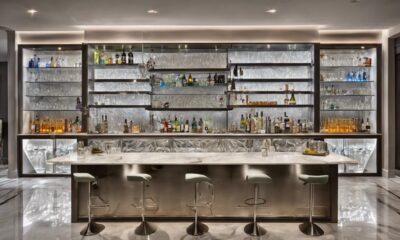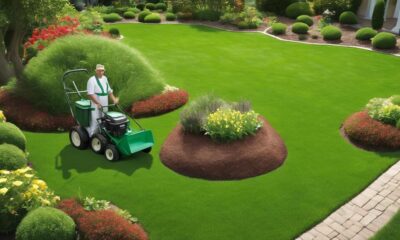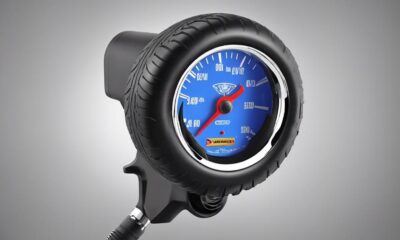Appliances
How Do You Match a Ceiling Fan?
2025
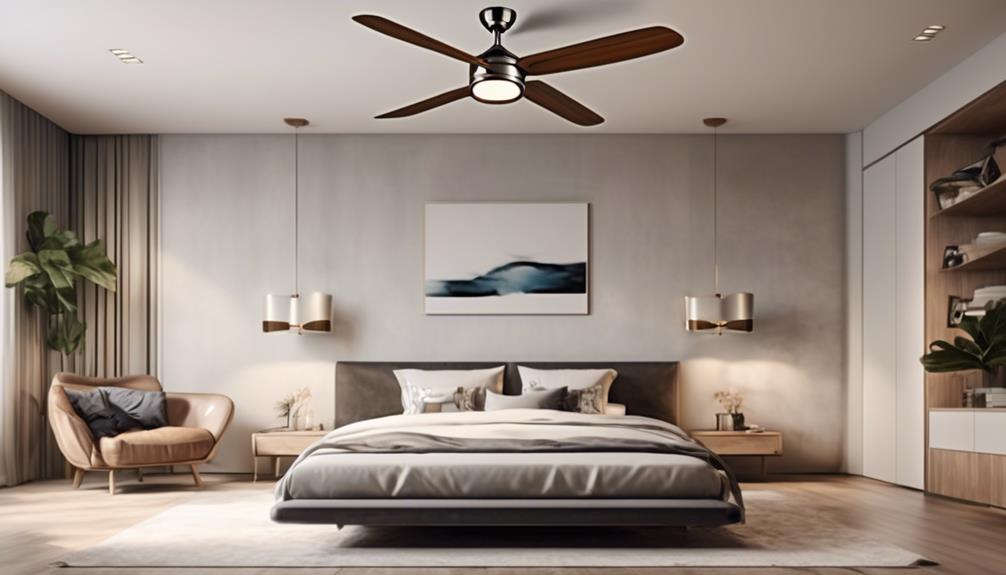
In the process of selecting a suitable ceiling fan, various elements need to be taken into account. Evaluating the size of the room and the height of the ceiling, taking into account the necessity for airflow, and figuring out the appropriate fan size along with the extent of the blades are critical actions in this procedure.
Additionally, you'll need to choose between indoor and outdoor ceiling fans, explore different styles and designs, and select the right finish for the fan. Considering additional features like remote control or reversible blades is also crucial.
Once you've made these decisions, determining the installation method and finalizing your choice based on budget and warranty considerations will complete the process.
Matching a ceiling fan may seem daunting, but with careful consideration and these guidelines, you can find the perfect fit for your space.
Key Takeaways
- The size of the room, including the length, width, and height, determines the appropriate fan size and blade span.
- Assess the airflow requirements of the room based on its size, shape, and intended use to determine the necessary CFM rating of the fan.
- Consider the room layout and furniture placement to ensure unobstructed airflow throughout the space.
- Take into account the ceiling height when selecting a fan, and choose a suitable mounting option based on the ceiling height and slope.
Assess Room Dimensions and Ceiling Height
When assessing room dimensions and ceiling height for matching a ceiling fan, it's crucial to gather accurate measurements to ensure a proper fit and optimal performance. Assessing room dimensions involves measuring the length, width, and height of the room. These measurements will help determine the appropriate size of the fan to create a balanced airflow. The size of the room is a key factor in selecting a fan with the right blade span. For larger rooms, a fan with a larger blade span is recommended to effectively circulate air. On the other hand, smaller rooms require fans with smaller blade spans to avoid overpowering the space.
Ceiling height is another important consideration when selecting a ceiling fan. The ideal height for a ceiling fan is 8 to 9 feet from the floor to the fan blades. This ensures proper air circulation without the risk of the fan being too low and causing injuries or obstructing movement in the room. For ceilings higher than 9 feet, the use of downrods can lower the fan to the appropriate height. Downrods allow for flexibility in adjusting the fan's height to maintain optimal performance.
Consider the Airflow Requirements
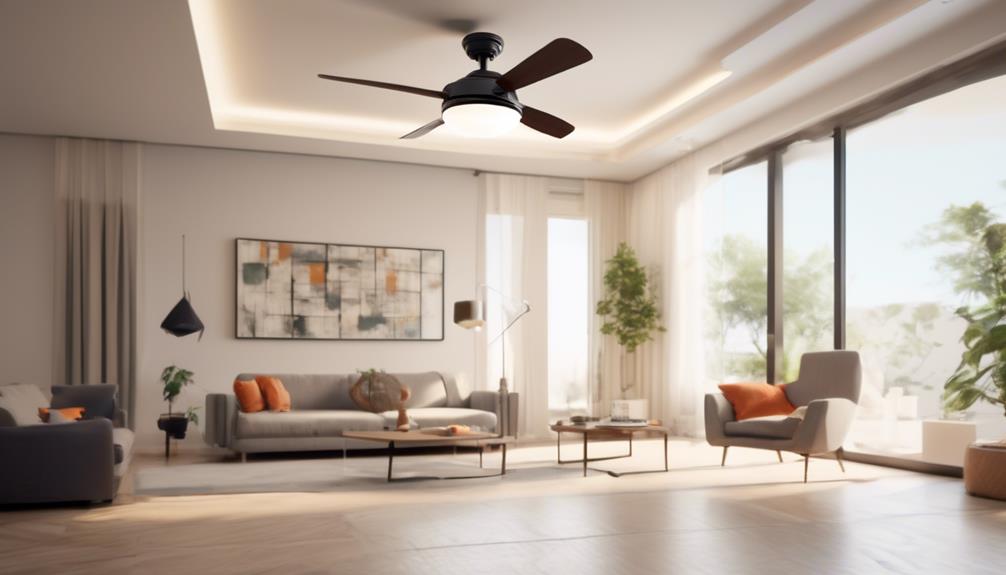
When considering the airflow requirements for a ceiling fan, there are a few points to keep in mind.
First, you need to assess the airflow capacity of the fan, which is typically measured in cubic feet per minute (CFM). This capacity should be sufficient to circulate the air in the room effectively.
Additionally, it's important to consider the size and layout of the room, as larger or oddly shaped rooms may require fans with higher CFM ratings to ensure adequate airflow.
Airflow Capacity Considerations
To ensure optimal airflow capacity for your ceiling fan, it's crucial to consider the specific requirements of the space in which it will be installed. By conducting an airflow capacity analysis, you can determine the fan's ability to circulate air effectively. Here are three key factors to consider:
- Room Size: The size of the room plays a significant role in determining the required airflow capacity. Larger rooms typically require fans with higher airflow capacity to ensure proper air circulation.
- Ceiling Height: The height of the ceiling affects the fan's ability to distribute air. For taller ceilings, fans with higher airflow capacity are necessary to overcome the distance and deliver adequate airflow to the living space.
- Room Function: The intended use of the room is another essential consideration. Rooms with high occupancy or heat-generating equipment may require fans with greater airflow capacity to maintain a comfortable environment.
Room Size and Layout
How does the size and layout of a room impact the airflow requirements for a ceiling fan?
When considering the room size and layout, it's essential to assess the air circulation needs to ensure optimal performance of the ceiling fan.
The dimensions of the room play a crucial role in determining the size of the fan needed. A larger room will require a fan with a greater airflow capacity to effectively circulate the air.
Additionally, the layout of the room, including any obstacles or furniture placement, can affect the airflow patterns. It's important to position the fan in a location that allows for unobstructed airflow throughout the room.
Determine the Fan Size and Blade Span
When determining the fan size and blade span for a ceiling fan, there are several important points to consider.
First, the size of the room will dictate the appropriate fan size, as larger rooms require fans with greater airflow capacity.
Additionally, the blade span of the fan is crucial in determining the airflow efficiency, with longer blades generally providing better circulation.
Lastly, it's essential to take into account the ceiling height, as certain fan sizes and blade spans may not be suitable for low ceilings.
Fan Size and Room
Determining the appropriate fan size and blade span is crucial for ensuring optimal air circulation in a room. When considering the fan size and room, there are several factors to take into account:
- Assessing fan placement: Before determining the size of the fan, it's important to assess the placement of the fan in the room. Consider the layout, furniture arrangement, and any obstacles that may affect the airflow.
- Determining optimal fan height: The height at which the fan is installed can greatly impact its effectiveness. A general rule of thumb is to hang the fan at least 7 feet above the floor for safety and optimal air circulation.
- Matching fan size to room dimensions: The size of the fan should be proportional to the room dimensions. A larger room will require a larger fan with a larger blade span to effectively circulate the air. Conversely, a smaller room will require a smaller fan.
Blade Span and Airflow
Assessing the appropriate blade span is essential for determining the optimal fan size and achieving efficient airflow in a room. The blade span refers to the diameter of the fan when the blades are fully extended. It directly affects the amount of air that the fan can move and the overall comfort level in the room.
A larger blade span typically means greater airflow, but it's important to consider the room size and ceiling height when selecting the blade span.
Additionally, the blade material can also impact the fan's performance. Blades made from materials such as wood or composite tend to be quieter and more efficient compared to metal blades.
It's crucial to choose a fan with the right blade span and material to ensure proper airflow and minimize energy consumption.
Ceiling Height Considerations
To accurately determine the appropriate size and blade span for a ceiling fan, it's crucial to consider the height of the room's ceiling. Ceiling height plays a significant role in the effectiveness and efficiency of a ceiling fan's performance.
Here are three important considerations for ceiling height when it comes to ceiling fan placement and installation:
- Optimal Mounting Height: For standard 8-foot ceilings, a flush mount or low-profile ceiling fan is recommended to ensure the blades are at least 7 feet above the floor. For higher ceilings, a downrod can be used to lower the fan to the appropriate height for optimal air circulation.
- Safety Clearance: It's essential to maintain a safe distance between the ceiling fan blades and any obstructions such as light fixtures or beams. A minimum clearance of 18 inches is typically recommended to prevent accidents and ensure smooth operation.
- Sloped Ceiling Adaptability: If your ceiling has a slope, make sure to choose a ceiling fan that's compatible with sloped ceilings. This will ensure proper installation and maximize the fan's performance.
Choose Between Indoor and Outdoor Ceiling Fans
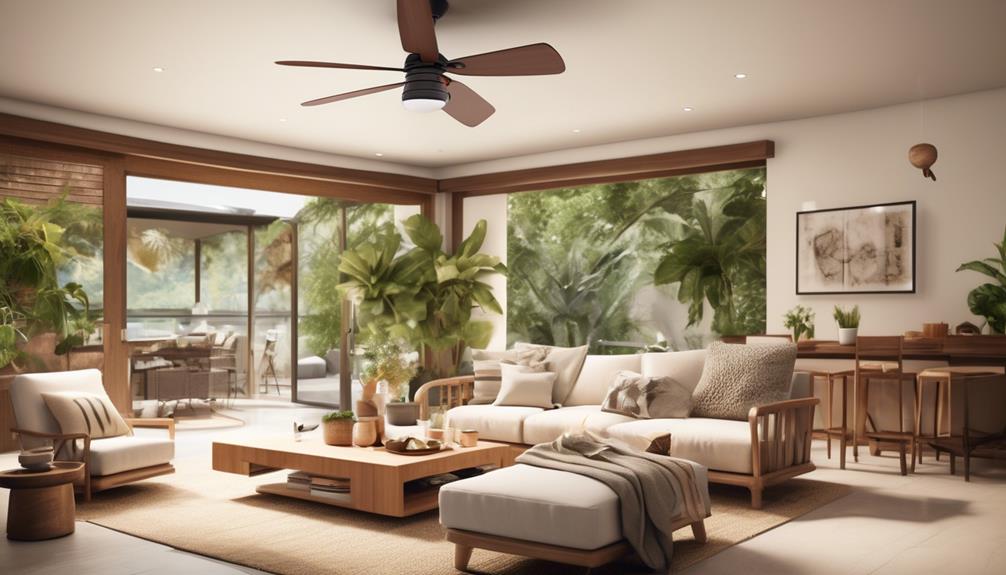
When choosing between indoor and outdoor ceiling fans, we must consider the specific environment and requirements for each space. Assessing the fan location is crucial in determining whether an indoor or outdoor fan is the right choice.
Indoor fans are designed for controlled environments and aren't built to withstand the elements. On the other hand, outdoor fans are specifically designed to withstand various outdoor conditions such as rain, humidity, and extreme temperatures.
One important factor to consider is the durability of outdoor fans. These fans are constructed with materials that are resistant to rust and corrosion. They're also designed to be water-resistant, ensuring they can withstand rain and humidity without damage. Additionally, outdoor fans have special coatings that protect them from UV rays, preventing discoloration and fading over time.
It is essential to choose an outdoor fan that's UL listed for damp or wet locations, depending on the specific outdoor environment. Damp-rated fans are suitable for covered outdoor areas that aren't directly exposed to rain. Wet-rated fans, on the other hand, are designed for open outdoor spaces where they may come into direct contact with rain.
Explore Different Fan Styles and Designs
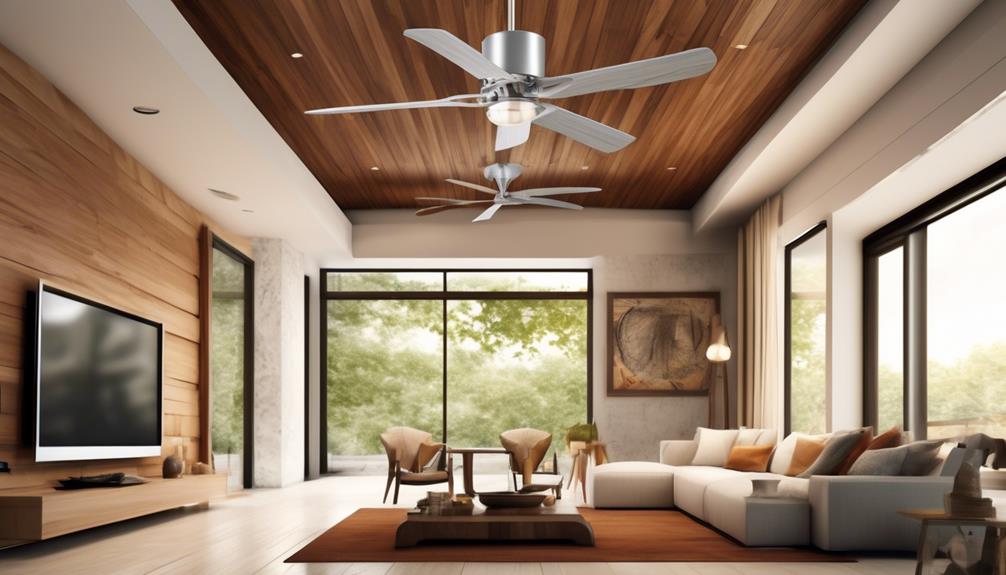
When it comes to exploring different fan styles and designs, there are a variety of options to choose from.
Popular fan styles include traditional, contemporary, and rustic, each offering a unique aesthetic to complement your home decor.
Additionally, there are fans with unique designs such as those inspired by nature, vintage styles, or even modern art.
Taking the time to explore these different styles and designs will help you find a ceiling fan that not only matches your needs but also adds a touch of personality to your space.
Popular Fan Styles
We will now explore different fan styles and designs, focusing on popular choices among consumers.
When it comes to popular fan styles, there are three options that stand out:
- Contemporary: This style features sleek lines and minimalist designs, making it a favorite among those who prefer a modern aesthetic. Contemporary fans often come in popular finishes like brushed nickel or matte black, adding a touch of sophistication to any room.
- Traditional: For those who prefer a more classic look, traditional fan styles are a popular choice. These fans often feature ornate details, such as decorative blades or intricate motor housings. Popular finishes for traditional fans include antique brass and oil-rubbed bronze, adding a timeless elegance to the space.
- Energy Efficient: With sustainability becoming increasingly important, energy efficient fan models are gaining popularity. These fans are designed to consume less energy while still providing effective airflow. They often come with features like LED lights and DC motors, making them a practical and eco-friendly choice.
Unique Fan Designs
Moving on from popular fan styles, let's now explore the realm of unique fan designs, showcasing a variety of innovative and distinct options to suit different tastes and preferences.
When it comes to unique fan designs, the possibilities are endless. From sleek and modern designs to vintage-inspired and artistic options, there's a fan for every style and aesthetic.
One popular trend in unique fan designs is the incorporation of energy-efficient options. These fans not only provide excellent performance but also help reduce energy consumption and lower electricity bills.
Some energy-efficient options include DC motor fans, which are significantly more efficient than traditional AC motor fans, and fans with integrated LED lights, which provide both lighting and cooling in one stylish package.
With unique fan designs, you can create a statement piece while also making a conscious choice towards sustainability.
Consider the Fan's Energy Efficiency
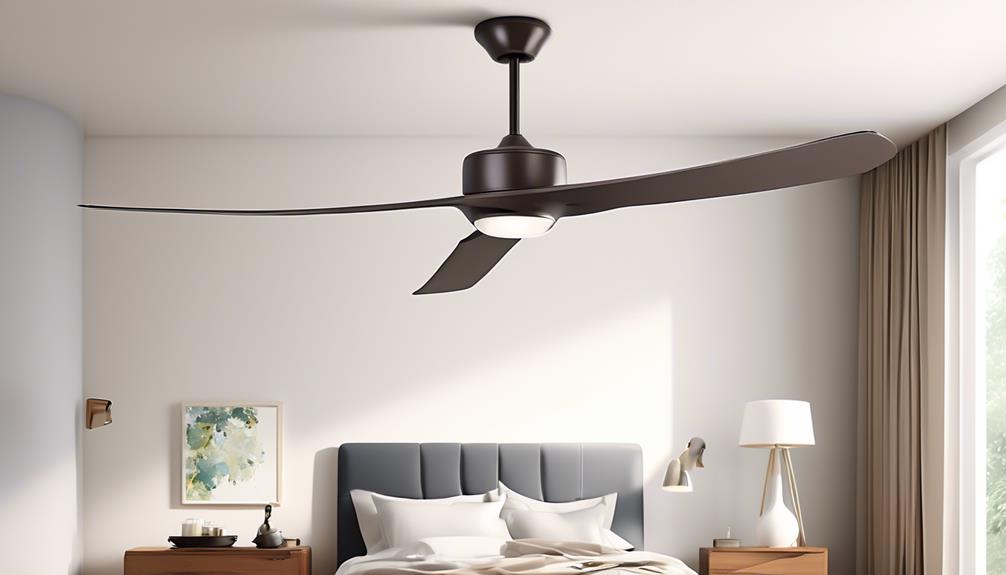
To ensure optimal energy efficiency, it's important to carefully consider the fan's energy consumption. Here are three key factors to keep in mind when evaluating a ceiling fan's energy efficiency:
- Motor Efficiency: The motor is the heart of the fan and plays a significant role in its energy consumption. Look for fans with motors that are specifically designed to be energy efficient. High-quality motors are typically equipped with advanced technologies, such as energy-saving DC motors or efficient AC motors. These motors not only consume less electricity but also operate quietly and have a longer lifespan.
- Blade Design: The design and shape of the fan blades can greatly impact its energy efficiency. Look for blades that are aerodynamically optimized to maximize airflow while minimizing energy consumption. Fan blades with a steeper pitch, larger surface area, and efficient airfoil shape can move more air using less energy. Additionally, consider the number of blades – fewer blades generally require less energy to operate.
- Energy Star Certification: Energy Star certified ceiling fans meet strict energy efficiency guidelines set by the Environmental Protection Agency (EPA). Choosing an Energy Star certified fan ensures that you're selecting a highly energy-efficient option. These fans not only provide significant energy efficiency benefits but also offer substantial cost savings over their lifespan.
Select the Appropriate Fan Motor Type

After carefully considering the fan's energy efficiency, the next step is to select the appropriate fan motor type. The fan motor is the heart of the ceiling fan and plays a crucial role in determining its performance and energy efficiency. When choosing a fan motor, it's important to assess its power and evaluate its energy efficiency.
To assess motor power, you need to consider the size of the room where the fan will be installed. A larger room will require a motor with more power to effectively circulate the air. The motor power is typically measured in terms of horsepower (HP) or watts (W), with higher values indicating a more powerful motor.
In addition to motor power, it's crucial to evaluate the energy efficiency of the fan motor. Look for motors that are labeled as Energy Star certified, as these have been tested and proven to meet strict energy efficiency guidelines. Energy-efficient motors not only consume less electricity but also generate less heat, resulting in lower energy bills.
Furthermore, consider the motor's construction and design. Look for motors with high-quality materials and advanced technologies that ensure smooth and quiet operation. A well-designed motor will also have better heat dissipation and durability, contributing to its overall efficiency and longevity.
Decide on the Number of Fan Blades
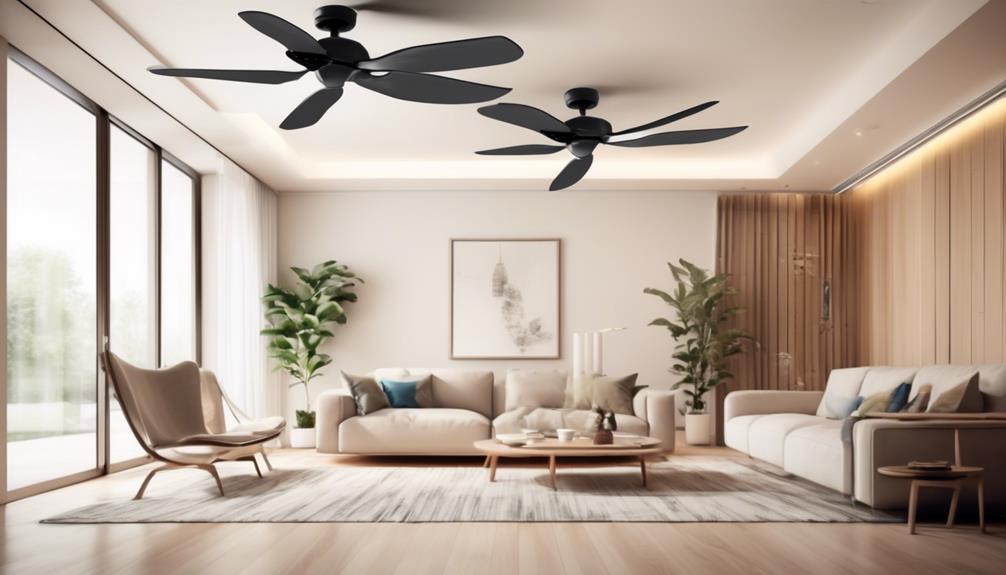
When deciding on the number of fan blades, it's important to consider factors that affect the fan's performance and airflow efficiency. Assessing airflow and considering aesthetics are two key considerations when selecting the number of fan blades.
- Optimal Airflow: The number of fan blades directly impacts the amount of airflow generated by the fan. A higher number of blades generally creates a more turbulent airflow, resulting in increased air circulation. However, too many blades can also create excessive drag, reducing the overall efficiency of the fan. It's crucial to strike a balance between the number of blades and the desired airflow.
- Noise Level: The number of fan blades can also influence the noise level produced by the fan. Fans with a greater number of blades tend to operate more quietly compared to those with fewer blades. This can be attributed to the higher number of blades evenly distributing the airflow, minimizing noise caused by turbulence.
- Aesthetics: The number of fan blades also plays a role in the overall appearance of the fan. Fans with a higher number of blades often have a more traditional and classic look, while those with fewer blades tend to have a sleeker and more modern appearance. Consider the aesthetic style of your space and choose a fan with the appropriate number of blades to complement the overall design.
Evaluate the Noise Level of the Fan

When evaluating the noise level of a ceiling fan, there are a few key points to consider.
Firstly, it's important to assess the noise level of the fan, as it can greatly impact the comfort and tranquility of a room.
Additionally, comparing the noise levels of different fans can help in selecting a model that meets your specific noise preferences.
Noise Level Assessment
To assess the noise level of the fan, we'll measure and evaluate the sound produced during operation.
Here are three important factors to consider when evaluating the noise level of a ceiling fan:
- Room Layout: The size and layout of the room can affect how the fan noise is perceived. For example, a fan installed in a small, enclosed space may seem louder than the same fan installed in a larger, open area. It's important to consider the acoustics of the room when assessing the noise level.
- Energy Efficiency: The energy efficiency of the fan can also impact its noise level. Fans with higher energy efficiency tend to operate more quietly. Look for fans that are ENERGY STAR certified, as they meet strict energy efficiency guidelines and are designed to operate quietly.
- Noise Rating: Pay attention to the noise rating of the fan, usually measured in decibels (dB). Fans with lower noise ratings produce less sound and are generally quieter. Look for fans with noise ratings below 40 dB for a quieter operation.
Fan Noise Comparison
We will compare the noise levels of different ceiling fans to determine their relative quietness and help you find the most suitable option for your needs. Fan noise reduction is an important factor to consider when choosing a ceiling fan, especially if you want a peaceful and quiet environment. To provide a comparative analysis of fan noise levels, we have created a table below that showcases the noise level ratings of three popular ceiling fans. The noise levels are measured in decibels (dB), with a lower value indicating a quieter fan. This table will assist you in making an informed decision based on the noise level preferences you desire.
| Ceiling Fan | Noise Level (dB) |
|---|---|
| Fan A | 40 dB |
| Fan B | 45 dB |
| Fan C | 38 dB |
Determine the Optimal Fan Control Options
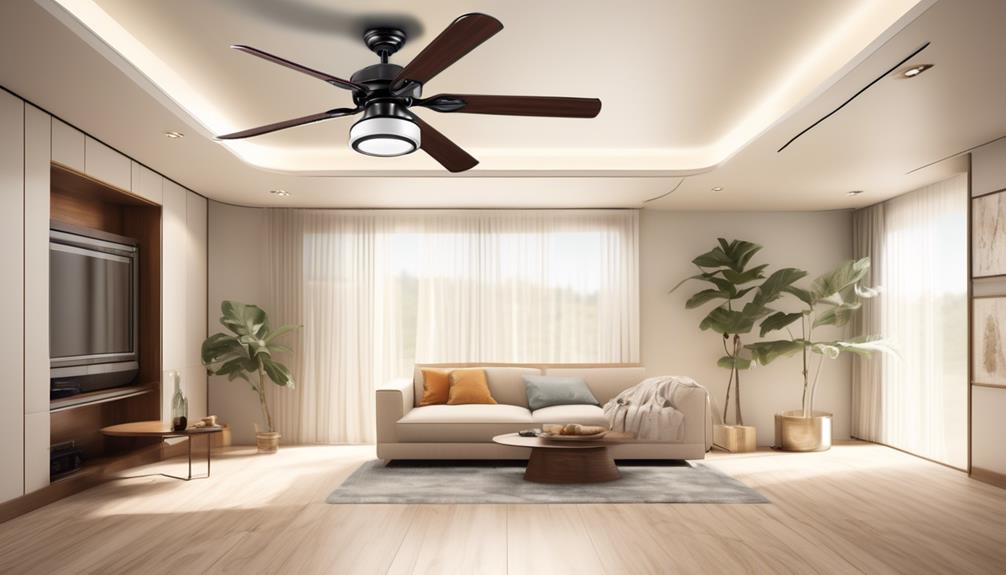
For optimal control options, consider using a combination of fan speed settings, remote control functionality, and smart home integration. These features not only enhance convenience and comfort but also provide greater control over your ceiling fan.
Here are three key aspects to consider:
- Fan Speed Settings: Choose a fan that offers multiple speed settings to cater to your specific cooling needs. Assessing energy consumption is crucial, as higher speed settings tend to consume more energy. Opt for a fan with energy-efficient speed options to minimize electricity usage while maintaining optimal airflow.
- Remote Control Functionality: Remote control functionality allows you to effortlessly adjust the fan speed, direction, and lighting without having to physically reach for a wall switch. This feature is particularly useful when you want to make quick adjustments or control multiple fans in different areas of your home.
- Smart Home Integration: Consider integrating your ceiling fan with a smart home system for seamless control through voice commands or smartphone apps. Smart fans can be programmed to operate based on your preferences, schedule, and even weather conditions. This advanced integration not only adds convenience but also allows for energy-saving automation and increases the overall aesthetic appeal of your space.
Consider the Lighting Options for the Fan

Consider the available lighting options when selecting a ceiling fan. The lighting options for ceiling fans can greatly enhance the functionality and aesthetics of a room. When it comes to lighting, there are several factors to consider, including the type of lighting, the number of bulbs, and the energy efficiency of the fixtures.
To help you make an informed decision, we have provided a table below outlining the different lighting options commonly found in ceiling fans:
| Lighting Option | Description | Energy Efficiency |
|---|---|---|
| Integrated Light Kit | These ceiling fans come with a built-in light fixture, offering a seamless and cohesive look. | Varies depending on the type of bulbs used. LED bulbs are highly energy-efficient. |
| Bowl Light Kit | Bowl light kits are mounted below the fan, providing a diffused and ambient lighting effect. | Varies depending on the type of bulbs used. LED bulbs are highly energy-efficient. |
| Spotlight Kit | Spotlight kits feature adjustable lights that can be directed to specific areas of the room, allowing for task lighting. | Varies depending on the type of bulbs used. LED bulbs are highly energy-efficient. |
| No Light Kit | Some ceiling fans are designed without a light kit for those who prefer a minimalist look or already have sufficient lighting in the room. | N/A |
When choosing a lighting option for your ceiling fan, it is important to consider the energy efficiency of the fixtures. Opt for LED bulbs, as they consume significantly less energy and have a longer lifespan compared to traditional incandescent bulbs. Additionally, consider the brightness and color temperature of the bulbs to ensure they suit your specific lighting needs.
Choose the Right Finish for the Fan
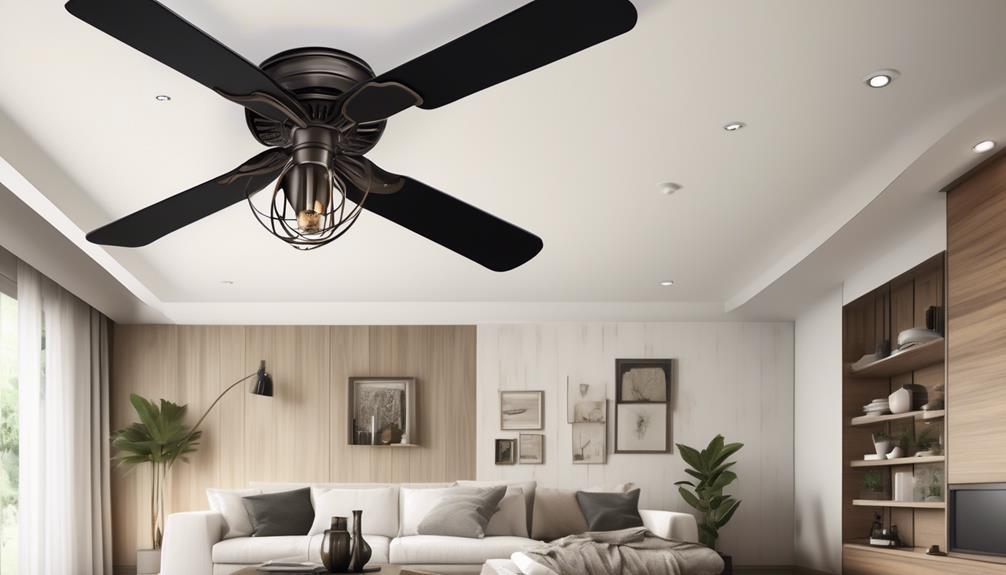
To ensure the best match for your ceiling fan, carefully consider the appropriate finish for the fan. The finish of a ceiling fan plays a crucial role in its overall appearance and how well it blends with your existing décor.
Here are three essential considerations when selecting the right finish for your ceiling fan:
- Match the existing finishes: Take a close look at the finishes of your other fixtures and furniture in the room where the fan will be installed. Choose a fan finish that complements or matches the existing finishes. This will create a cohesive and harmonious look in the space.
- Consider the room's style: The style of the room should also influence your decision. For a modern or contemporary space, sleek and minimalistic finishes like brushed nickel or chrome can work well. Traditional or rustic rooms may benefit from finishes like oil-rubbed bronze or aged brass.
- Consider maintenance and durability: Different finishes require different maintenance levels. Some finishes, like stainless steel or matte black, are more resistant to fingerprints and smudges, making them easier to clean and maintain. Additionally, consider the durability of the finish. Choose a high-quality finish that can withstand regular use and maintain its appearance for years to come.
Consider Additional Features, Such as Remote Control or Reversible Blades

We can explore additional features for your ceiling fan, such as remote control or reversible blades, to enhance its functionality and convenience. Incorporating a remote control into your ceiling fan allows you to conveniently adjust the fan's speed, direction, and lighting without having to get up from your seat. With just a press of a button, you can easily customize your comfort level and create the ideal atmosphere in your space.
Additionally, opting for a ceiling fan with reversible blades offers several advantages. During the summer months, you can set the blades to rotate counterclockwise, creating a cooling breeze that helps lower the room temperature. In the winter, you can reverse the blade direction to clockwise, which helps to circulate warm air that rises to the ceiling and pushes it back down into the room, providing better heat distribution and increasing energy efficiency.
To summarize the benefits of remote control and reversible blades, we have created a table below:
| Remote Control Benefits | Reversible Blade Advantages |
|---|---|
| Convenient adjustment of fan speed, direction, and lighting | Cooling breeze during summer months |
| Customizable comfort level and atmosphere | Better heat distribution in winter |
| No need to get up from your seat | Increased energy efficiency |
Determine the Installation Method for the Ceiling Fan

Determining the installation method for your ceiling fan involves carefully considering the structural requirements and electrical connections in your space. To ensure a successful installation, here are three key factors to consider:
- Structural Support: Before installing a ceiling fan, it's crucial to determine if your ceiling can support the weight and movement of the fan. Ceiling fans can be heavy, especially those with additional features like lights or larger blade spans. Make sure to locate a sturdy ceiling joist or use a ceiling fan-rated support brace for added stability.
- Electrical Connections: Proper electrical connections are essential for the safe and efficient operation of your ceiling fan. Ensure that your electrical circuit can handle the fan's power requirements by checking the amperage rating. It's also important to have a suitable wall switch or remote control system in place to control the fan's speed and lighting options.
- Airflow Requirements: Consider the airflow requirements of your space when choosing a fan installation method. If you have a high ceiling, you may need to use a downrod to lower the fan closer to the desired airflow level. Conversely, for low ceilings, a flush-mount installation method is more suitable to maximize headroom.
Finalize Your Decision Based on Budget and Warranty Considerations
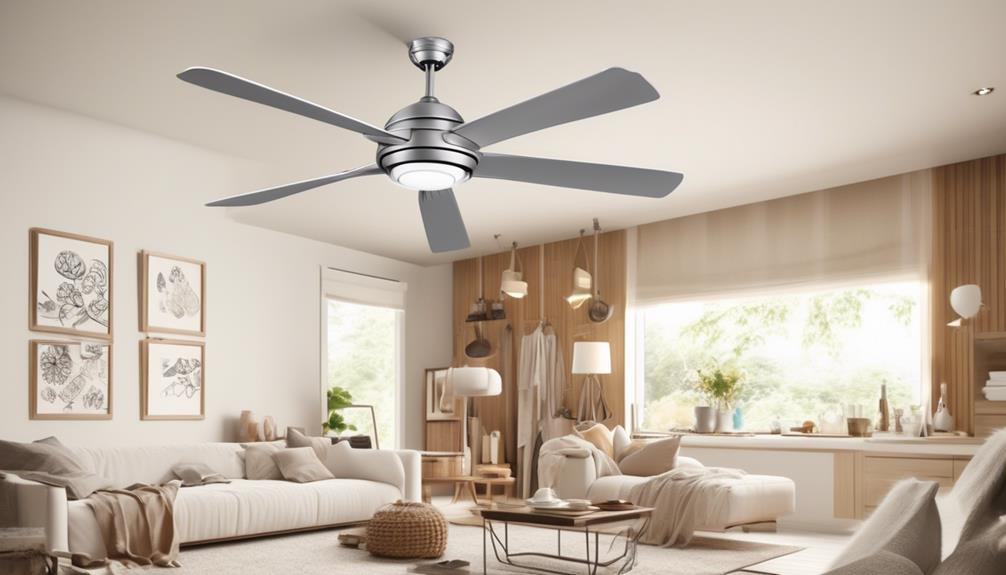
After carefully considering the structural requirements and electrical connections for your ceiling fan installation, it's essential to finalize your decision based on budget and warranty considerations.
Taking budget considerations into account ensures that you choose a ceiling fan that not only meets your needs but also fits within your financial constraints. Ceiling fans come in a wide range of prices, so it's important to establish a budget before beginning your search. Consider factors such as the size of the room, the features you desire, and the quality of the materials. Higher-priced fans often offer more advanced features, such as remote controls, adjustable speeds, and reversible motor functions. However, it's important to strike a balance between price and functionality to ensure that you get the most value for your money.
Another crucial aspect to consider is the warranty options provided by the manufacturer. A warranty not only protects your investment but also gives you peace of mind knowing that you're covered in the event of any unexpected issues. Look for a ceiling fan that offers a comprehensive warranty, covering both the motor and other components. Additionally, pay attention to the length of the warranty as longer warranties generally indicate a higher level of confidence in the product's quality.
Can Matching a Ceiling Fan Help Cover a Hole in a Light Fixture in the Ceiling?
Yes, matching a ceiling fan can help in covering a hole in fixture. By choosing a fan that is the same size as the existing light fixture, the hole can be effectively hidden. This can be a simple and cost-effective solution to addressing the issue of a hole in the ceiling.
Frequently Asked Questions
Can I Install a Ceiling Fan in a Bathroom or Other High-Moisture Areas?
Yes, you can install a ceiling fan in a bathroom or other high-moisture areas.
Ceiling fan safety and proper ventilation are crucial factors to consider in these spaces.
It's important to choose a ceiling fan that's specifically designed for damp or wet locations.
These fans are built with materials and features that can withstand the moisture and humidity present in bathrooms or other high-moisture areas.
Proper ventilation is essential to prevent damage and ensure the longevity of your ceiling fan.
Are There Any Regulations or Safety Guidelines for Installing a Ceiling Fan?
When it comes to installing a ceiling fan, it's important to follow regulations and safety guidelines to ensure proper installation and optimal safety.
Ceiling fan installation tips and best practices for ceiling fan safety should be adhered to, as they provide the necessary guidance for a successful installation.
How Do I Determine the Appropriate Height to Hang the Fan From the Ceiling?
To determine the appropriate height to hang the fan from the ceiling, we need to consider a few factors.
First, measure the height of your ceiling to ensure you have enough clearance for the fan blades.
Next, consider the room size and choose an appropriate fan size that will effectively circulate air.
Lastly, follow the manufacturer's guidelines for installation, as they may provide specific recommendations for fan height.
Are There Any Specific Maintenance Requirements for Ceiling Fans?
Ceiling fan maintenance is essential for optimal performance and longevity. Regular cleaning is necessary to prevent dust buildup and maintain proper airflow.
Additionally, checking the fan's balancing and tightening any loose screws is crucial to prevent wobbling. It's also important to inspect the fan blades for any signs of damage or wear.
Addressing these common problems promptly can help ensure your ceiling fan functions efficiently and lasts for years to come.
Can I Install a Ceiling Fan on a Sloped or Vaulted Ceiling?
When installing ceiling fans on low ceilings or sloped/vaulted ceilings, it's important to choose the right size fan for your space.
Measure the height of your ceiling to determine the appropriate fan size.
For low ceilings, opt for a hugger or flush mount fan to ensure proper clearance.
For sloped/vaulted ceilings, select a fan with an angled mounting kit to accommodate the slope.
Proper installation and sizing will ensure optimal airflow and functionality of your ceiling fan.
Conclusion
After assessing room dimensions, airflow requirements, and design preferences, choosing the right ceiling fan becomes an important decision.
Interestingly, a study conducted by Energy Star found that using a ceiling fan in conjunction with an air conditioner can save up to 30% on cooling costs.
Taking into account factors like size, style, and installation method, selecting the perfect ceiling fan can greatly enhance both comfort and energy efficiency in any space.
- About the Author
- Latest Posts
Introducing Ron, the home decor aficionado at ByRetreat, whose passion for creating beautiful and inviting spaces is at the heart of his work. With his deep knowledge of home decor and his innate sense of style, Ron brings a wealth of expertise and a keen eye for detail to the ByRetreat team.
Ron’s love for home decor goes beyond aesthetics; he understands that our surroundings play a significant role in our overall well-being and productivity. With this in mind, Ron is dedicated to transforming remote workspaces into havens of comfort, functionality, and beauty.
Garage Door Opener
DIY: Install Garage Door Opener Keypad in 10 Steps
Journey into seamless garage access with our 10-step guide to installing a keypad – unlocking convenience at your fingertips.

When it comes to improving the functionality of your garage door system, adding a keypad can offer a convenient way to enter your garage.
However, the process of installing one might seem daunting at first glance. But fear not, as we have broken down the steps into a clear and concise guide that will have you confidently tackling this project in no time.
Stay tuned for essential tips and tricks that will ensure a smooth installation process and have you enjoying the convenience of your newly installed keypad in no time.
Key Takeaways
- Plan and prepare tools and location for keypad installation with attention to accessibility and visibility.
- Protect the keypad from weather elements with proper positioning and a weatherproof cover.
- Program the keypad securely, ensuring alignment and stability for optimal performance.
- Verify wiring connections, test the keypad's functionality, and finalize installation with thorough checks for proper operation.
Gather Required Tools and Materials
To begin the installation process smoothly, ensure we've all the necessary tools and materials at hand, such as a screwdriver, screws, and the keypad itself. When gathering these items, make sure they're compatible with your specific garage door opener model. It's crucial to have everything organized and easily accessible outside the garage where the installation will take place. Check the contents of the keypad box to confirm all components are included, avoiding any setbacks during the setup. Having a stable surface to lay out the tools and materials will facilitate quick access and prevent any potential mishaps.
Proper preparation is key to a successful installation. By ensuring we've the correct tools and materials ready beforehand, we can make the process more efficient and eliminate unnecessary delays. By double-checking and gathering all necessary items outside the garage, we set the stage for a smooth and hassle-free installation of the garage door opener keypad.
Locate the Ideal Placement

When choosing the ideal placement for your garage door opener keypad, we need to consider a few key points.
Ensure the keypad is strategically positioned for easy access by all users, at a comfortable height.
Additionally, think about weather protection to prolong the keypad's lifespan.
Choose Strategic Position
For optimum accessibility and ease of use, position the keypad at a height that caters to both adults and children while ensuring comfortable operation.
When choosing the strategic position for the garage door opener keypad, consider installing it at a level that's easily reachable for all users. Ensure the keypad isn't too high or too low, allowing for convenient operation without straining or bending.
Take note of any potential obstructions or interferences in the selected mounting location to avoid issues with functionality. Additionally, aim to place the keypad in a well-lit area that provides clear visibility for entering the pin code, enhancing user experience and security.
Consider these factors to determine the ideal placement for the keypad to optimize its functionality within your garage.
Ensure Easy Access
Positioning the garage door opener keypad at a height accessible to all users, typically around 5 feet from the ground, ensures convenient and easy access for efficient operation.
Placing the keypad in a well-lit area enhances visibility, especially during nighttime use. Be mindful of obstructions or sharp edges that could obstruct the keypad's functionality and accessibility.
Opt for a location shielded from extreme weather conditions to prolong the keypad's lifespan. Validate the keypad's placement by testing it from various entry angles to guarantee effortless access.
Consider Weather Protection
After ensuring easy access for efficient operation, the next crucial step is to consider weather protection when locating the ideal placement for your garage door opener keypad. To shield the keypad from direct exposure to rain, snow, or extreme weather conditions, it is advisable to install it in a sheltered area. Look for spots under an eave or a covered porch to extend the keypad's lifespan. If mounting the keypad in an exposed area, consider weatherproofing it with a protective cover or housing. Choosing a location that minimizes contact with water and moisture is key to prevent damage and maintain functionality over time. Ensuring weather protection for the keypad is essential for outdoor installations to uphold performance and longevity.
| Placement | Protection |
|---|---|
| Under an eave | Shield from rain and snow |
| Covered porch | Protection from extreme weather |
| Weatherproof cover | Prevent direct exposure to moisture |
Prepare the Keypad Mounting Surface

To ensure a secure and professional installation, start by cleaning the mounting surface with a damp cloth to remove any dirt or debris that may affect the keypad's adherence.
Once the surface is clean, use a level to ensure it's flat before proceeding with the installation. This step is crucial in achieving a polished and secure finish for your keypad.
Additionally, consider using a stud finder to locate and mark the studs on the wall. This will provide added support when mounting the keypad, ensuring it stays securely in place.
It's important to avoid mounting the keypad near any moving parts of the garage door to prevent interference or damage during operation.
Lastly, double-check the mounting surface for stability and suitability before proceeding with the installation to avoid any potential issues down the line.
Following these steps will help you set up your keypad efficiently and effectively.
Install Batteries in the Keypad

Let's start by checking the keypad manual for the specific 9-volt battery needed and opening the battery compartment accordingly.
Make sure to insert the battery following the polarity markings inside the compartment and securely close it for proper functionality.
Testing the keypad afterward will confirm the correct installation of the battery and ensure the keypad is ready for use.
Battery Installation Process
For optimal keypad performance, ensure the correct batteries are installed according to the manufacturer's specifications. Here's how to install the batteries properly:
- Check the Keypad Manual: Look up the specific battery requirements, typically 9-volt or AAA batteries, in the manual.
- Open the Battery Compartment: Use a screwdriver or follow the keypad's sliding mechanism to access the battery compartment.
- Insert Batteries Correctly: Pay attention to the polarity markings inside the compartment and insert the batteries accordingly.
- Securely Close the Compartment: Ensure the battery compartment is closed securely to establish proper connection and functionality.
Remember to replace the batteries periodically to maintain peak performance for your keypad.
Powering Up the Keypad
After successfully installing the batteries in the keypad, the next step is to power up the device by closing the cover securely to ensure proper functionality. To emphasize the importance of battery maintenance and replacement, here is a table outlining key points:
| Battery Maintenance Tips | |
|---|---|
| 1. Check battery life regularly | 2. Ensure proper polarity alignment |
| 3. Replace batteries promptly when low | 4. Avoid mixing old and new batteries |
| 5. Keep the battery compartment clean and dry | |
Following these guidelines will help maintain the keypad's efficiency and prevent operational issues. Remember, a well-powered keypad is essential for seamless garage door opener functionality.
Program the Keypad With Your Opener

To program the keypad with your opener, locate the colored learn button near the motor unit of the garage door opener. Different colors of learn buttons indicate specific programming methods for the keypad. Follow the manufacturer's instructions, as they typically involve a sequence of button presses to initiate programming mode.
Here are the steps to program the keypad accurately:
- Identify the color of the learn button on your garage door opener.
- Enter the programming mode by pressing the designated buttons on the keypad.
- Input a four-digit pin that you'll use to operate the keypad.
- Press the learn button on the garage door opener to synchronize the keypad with the opener.
It is crucial to test the programmed keypad by entering the pin and operating the garage door. This ensures successful synchronization and allows you to verify that the keypad is working correctly with your garage door opener.
Secure the Keypad in Place

Let's ensure the keypad is securely fastened in place by carefully aligning it with the level before tightening the screws evenly. Ensuring the keypad is straight is crucial to prevent any future issues, such as misalignment or difficulties in using the keypad. Here is a handy table to guide you through securing the keypad:
| Step | Action |
|---|---|
| 1 | Use a level to check alignment. |
| 2 | Tighten screws evenly for stability. |
| 3 | Confirm snug fit against the wall. |
Connect the Wiring to the Opener

Let's now tackle the crucial step of connecting the wiring to the opener.
We'll provide an overview of the wiring connections, ensure proper wire termination, and test the connection for functionality.
This process is vital to ensure your keypad communicates effectively with the garage door opener.
Wiring Connections Overview
Before proceeding with the wiring connections for the keypad installation, ensure that the power to the garage door opener is turned off.
Here's an overview of the wiring connections process:
- Identify the terminals on the garage door opener where the keypad wiring will be connected.
- Match the keypad wires to the corresponding terminals on the opener based on the installation instructions.
- Use wire nuts to securely connect the keypad wires to the opener terminals for a reliable connection.
- Double-check the wiring connections to ensure they're properly seated and insulated before restoring power to the opener.
Proper Wire Termination
Have the wire strippers handy to carefully remove the insulation from the ends of the keypad wires before matching them to the corresponding terminals on the garage door opener.
Ensure to match the colors of the keypad wires to the designated terminals on the opener.
Insert each wire into its assigned terminal and securely tighten the screws to establish a reliable connection.
It's crucial to double-check all connections to confirm there are no loose wires or exposed copper, which could lead to electrical hazards.
Adhering to the manufacturer's guidelines for wire termination is essential to prevent any operational issues.
Following these steps diligently will help guarantee a safe and efficient installation of your garage door opener keypad.
Testing the Connection
After securely connecting the keypad wiring to the designated terminals on the garage door opener, the next crucial step is to test the connection to ensure proper functionality before finalizing the installation. Here are four essential steps to follow:
- Activate the Keypad: Press a few random numbers on the keypad to check if the display lights up and responds.
- Test with the Opener: Enter the access code followed by the open/close button to see if the garage door responds accordingly.
- Check for Consistency: Repeat the process multiple times to confirm consistent operation.
- Inspect for Errors: Look for any error codes or unusual behavior during testing to address any potential issues promptly.
Test the Keypad Functionality

To ensure the smooth operation of the keypad, thoroughly test its functionality by pressing all buttons to confirm responsiveness and entering the programmed PIN for seamless garage door control. When testing the keypad, ensure that each button responds promptly and accurately to your touch. Next, input the programmed PIN to verify that the garage door opens and closes as intended. Additionally, check if the keypad illuminates correctly for easy use in different lighting conditions. Look out for any error messages or beeping sounds that could signal problems with programming or connectivity. Evaluate the keypad's range by testing its operation from various distances to guarantee reliable performance.
| Keypad Functionality Test | ||
|---|---|---|
| Button Responsiveness | Programmed PIN Entry | Illumination Check |
| Error Message Detection | Range Evaluation |
Adjust Keypad Settings as Needed

Let's seamlessly continue our installation process by adjusting the keypad settings as needed for added security and convenience. Here are some essential adjustments you may want to consider:
- Change Pin Code: Enhance security by customizing the four-digit pin code on the keypad regularly.
- Customize Features: Take control of additional garage door opener features, such as lights, by customizing the keypad settings to suit your preferences.
- Time Delay Feature: Prevent accidental activation of the garage door opener by setting up a time delay feature on the keypad.
- Vacation Mode: Enable vacation mode on the keypad to disable remote access when you're away for an extended period, enhancing the security of your garage.
Remember to refer to the manufacturer's instructions for adjusting advanced settings on the keypad to ensure optimal performance.
Enjoy Your Newly Installed Keypad

Upon completing the installation of your new keypad, take a moment to familiarize ourselves with its functions and button layout for seamless operation. Understanding how each button corresponds to specific actions will enhance your experience with the keypad.
Test its functionality multiple times to ensure it consistently works as expected. Consider setting up temporary access codes for guests or service providers to make entry more convenient.
It's essential to keep the keypad clean and free from debris to maintain its functionality over time. Remember to note down the keypad's location and pin code for future reference or troubleshooting purposes.
Frequently Asked Questions
Can I Add a Keypad to Existing Garage Door Opener?
Yes, we can add a keypad to an existing garage door opener. It's a straightforward process that enhances security and provides keyless entry.
Keypads work with various garage door opener brands and models. This upgrade is cost-effective and seamlessly integrates into your current setup with proper installation and programming.
Enjoy the convenience and peace of mind that a keypad brings to your garage door system.
Which Is Better Wired or Wireless Garage Door Keypad?
When it comes to choosing between a wired or wireless garage door keypad, it's essential to weigh the pros and cons.
Wired keypads offer reliability without battery reliance, but may need professional installation due to wiring requirements.
On the other hand, wireless keypads provide flexibility and are easier to install DIY.
Understanding your preferences and garage door opener setup will help determine which option suits you best.
Can You Hardwire a Garage Door Keypad?
Yes, we can hardwire a garage door keypad. It involves connecting the keypad directly to the power source of the garage door opener for a reliable power supply. Check the keypad's instructions to confirm hardwiring compatibility and follow the correct steps.
This method offers a more stable power source than batteries, but it may not be essential for all setups. Hardwiring is an option for those seeking a consistent power solution.
Can You Install a Garage Door Opener by Yourself?
Yes, we can install a garage door opener by ourselves. It's a manageable task with the right tools and instructions. Doing it independently can save us money and give us a sense of accomplishment.
Before starting, ensure the opener is compatible with our system. Following step-by-step guides is key to success. With attention to detail and patience, most of us can tackle this project successfully and enjoy the convenience of a keypad entry system.
Conclusion
In conclusion, with our 10-step guide, installing a garage door opener keypad can be a straightforward DIY project that adds convenience to your daily routine.
Remember, 'measure twice, cut once' to ensure accuracy and precision during the installation process.
By following our detailed instructions and taking your time to do it right, you can enjoy the benefits of easy access to your garage with just a few simple clicks.
Happy keypad installing!
- About the Author
- Latest Posts
Introducing Ron, the home decor aficionado at ByRetreat, whose passion for creating beautiful and inviting spaces is at the heart of his work. With his deep knowledge of home decor and his innate sense of style, Ron brings a wealth of expertise and a keen eye for detail to the ByRetreat team.
Ron’s love for home decor goes beyond aesthetics; he understands that our surroundings play a significant role in our overall well-being and productivity. With this in mind, Ron is dedicated to transforming remote workspaces into havens of comfort, functionality, and beauty.
Garage Door Opener
How Much a LiftMaster Garage Door Opener Costs
Unravel the enigmatic world of LiftMaster garage door opener costs, where affordability meets intricate functionality in surprising ways – a revelation awaits beyond.

When exploring the complex balance between cost and quality in the world of LiftMaster garage door openers, individuals may find themselves wading through a variety of choices, each with its own specific price point. The fascinating aspect is uncovering the detailed factors that influence these differing costs, revealing the elements that ultimately impact the financial commitment required.
So, as we embark on unraveling the mystery behind how much a LiftMaster garage door opener truly costs, prepare to uncover a world where functionality meets affordability in unexpected ways.
Key Takeaways
- LiftMaster garage door openers range from $200-$600, with most models priced between $250-$475.
- Features include WiFi connectivity, AC/DC motor options, battery backup, and automatic door locks.
- LiftMaster openers excel in functionality, convenience, and security, offering reliable quality.
- Consider drive mechanism, horsepower, smart capabilities, and installation costs when selecting a LiftMaster opener.
LiftMaster Chain Drive Opener Prices
LiftMaster chain drive garage door openers offer a range of prices, typically spanning from $200 to over $600, with most models priced between $250-$475, catering to various budgets and garage door needs. These openers come equipped with advanced features like WiFi and Smart technology, ensuring seamless integration with modern smart home setups. Customers can choose between models with AC and DC motors, providing options based on power and efficiency requirements. Additionally, the inclusion of battery backup in all 11 chain drive models ensures operation during power outages, adding an extra layer of convenience and security.
The affordability of LiftMaster chain drive openers doesn't compromise on performance. Despite the varying price points, each model is designed to deliver reliable functionality and durability. Factors like horsepower and security features contribute to the overall cost but ensure that customers receive a high-quality product tailored to their specific garage door demands. Noise reduction capabilities further enhance the user experience, making LiftMaster chain drive openers a practical and efficient choice for homeowners seeking a balance between cost and performance.
LiftMaster Belt Drive Opener Costs

Belt drive garage door openers from LiftMaster typically fall within the price range of $300 to $600, offering a balance between cost and performance for homeowners seeking a quieter operation. These openers are known for their smooth operation, making them a popular choice for those looking to reduce noise levels in their garage. Some key features of LiftMaster belt drive openers include rubber belts reinforced with steel, ensuring durability and reliability. Additionally, these models come with extension kits suitable for 8 or 10-foot doors, providing versatility for different garage configurations.
Key Points:
- Quiet Operation: LiftMaster belt drive openers offer a quieter alternative to chain drive models, making them ideal for homes where noise is a concern.
- Smooth Performance: The rubber belt design, reinforced with steel, ensures smooth operation, reducing friction and wear.
- Mid-Range Cost: Priced between $300 and $600, these openers strike a balance between affordability and performance, appealing to homeowners looking for quality at a reasonable price.
LiftMaster Wall-Mount Opener Prices
When considering garage door opener options for your home, wall-mount models from LiftMaster are priced between $500 to $600, offering a space-saving solution designed for high or irregular ceilings. These openers come equipped with features like direct drive operation, WiFi connectivity, and Smart technology, making them a convenient and secure investment for your household. The automatic door lock feature adds an extra layer of security to your garage. Below is a breakdown of LiftMaster wall-mount opener prices:
| Features | Description | Price Range |
|---|---|---|
| Direct Drive | Smooth and quiet operation | $500 – $600 |
| WiFi Connectivity | Control your garage door remotely | $500 – $600 |
| Smart Technology | Integration with smart home systems | $500 – $600 |
| Auto Door Lock | Enhanced security feature | $500 – $600 |
| Space-Saving | Ideal for high ceilings and irregular spaces | $500 – $600 |
LiftMaster Opener Features Breakdown

After exploring the pricing details of the LiftMaster wall-mount opener options, we'll now analyze the specific features that make these garage door openers stand out in the market.
LiftMaster Opener Features Breakdown:
- Smart Technology Integration
LiftMaster garage door openers come equipped with WiFi connectivity, allowing users to operate their doors remotely through smartphones or other smart devices.
- Motor Options
LiftMaster offers a choice between AC and DC motors in their openers, providing users with flexibility based on their specific needs and preferences.
- Enhanced Convenience Features
Features like battery backup ensure that your garage door can still be operated during power outages, while automatic door locks provide added security and peace of mind.
These features set LiftMaster openers apart in terms of functionality, convenience, and security, making them a reliable choice for homeowners looking for a high-quality garage door opener.
Garage Door Opener Buying Guide
What key factors should be considered when selecting a LiftMaster garage door opener? When choosing a LiftMaster garage door opener, several crucial factors should guide your decision-making process. Consider the type of drive mechanism, horsepower, smart capabilities, and installation costs to ensure you select the best opener for your needs. Below is a breakdown of key considerations when purchasing a LiftMaster garage door opener:
| Factors to Consider | Details |
|---|---|
| Drive Mechanism | Choose between chain drive models for affordability or quieter operation with belt drives. |
| Horsepower | Select the right horsepower based on the size and weight of your garage door for optimal performance. |
| Smart Capabilities | Opt for smart garage door openers with built-in Wi-Fi for remote access and integration with your smart home system. |
| Installation Costs | Factor in installation costs, especially for wall-mounted models, to stay within your budget. |
Frequently Asked Questions
What Is the Best Liftmaster Garage Door Opener for 2023?
We recommend the LiftMaster 8550WLB for 2023, known for its quiet operation and advanced features.
It boasts a powerful DC motor, battery backup, and WiFi connectivity for remote control.
With MyQ technology, smartphone integration is seamless, enhancing convenience and security.
This model offers a lifetime warranty on the motor and belt, ensuring durability and peace of mind.
Homeowners seeking a reliable, high-performance garage door opener in 2023 should consider the LiftMaster 8550WLB.
What Is the Average Life of a Liftmaster Garage Door Opener?
We can expect a LiftMaster garage door opener to last about 10-15 years on average. These openers are renowned for their durability and long-lasting performance. Factors like regular maintenance and proper installation can help extend their lifespan.
LiftMaster models are designed to be reliable and robust, capable of handling frequent use over many years. Understanding this average lifespan can assist in planning for future maintenance or replacement needs.
Is Liftmaster a Good Garage Door Opener?
Yes, LiftMaster is a reliable choice for a garage door opener. Its enhanced security features, durable construction, noise reduction technology, and convenient remote operation make it a top contender.
The ability to control it through a mobile app like LiftMaster MyQ adds further convenience. Various models cater to different garage types, ensuring a suitable option for all needs.
Professional installation is recommended for optimal performance, and regular maintenance ensures longevity.
How Much Does It Cost to Install Liftmaster 8500w?
When considering the installation of a LiftMaster 8500W garage door opener, various factors like location, complexity, and additional services can influence costs. It's prudent to seek quotes from different installers to compare prices and service offerings.
Costs typically range from $150 to $350 for professional installation, although DIY installation is an option. However, improper DIY installation might void the warranty. Some professionals include installation costs in the overall opener price.
Conclusion
In conclusion, the cost of a LiftMaster garage door opener can vary depending on the model and features selected.
Like a well-oiled machine, these openers offer a range of options to suit different budgets and needs, from chain drive models to smart technology.
With prices ranging from $200 to $1,000, there's a LiftMaster opener for every garage door, ensuring smooth and reliable operation for years to come.
- About the Author
- Latest Posts
Introducing Ron, the home decor aficionado at ByRetreat, whose passion for creating beautiful and inviting spaces is at the heart of his work. With his deep knowledge of home decor and his innate sense of style, Ron brings a wealth of expertise and a keen eye for detail to the ByRetreat team.
Ron’s love for home decor goes beyond aesthetics; he understands that our surroundings play a significant role in our overall well-being and productivity. With this in mind, Ron is dedicated to transforming remote workspaces into havens of comfort, functionality, and beauty.
Garage Door Opener
10 Easy Steps to Wire Your Liftmaster Garage Door Opener
Unveil the secrets to wiring your Liftmaster garage door opener effortlessly in 10 simple steps – are you ready to upgrade your garage door experience?

On average, a garage door opener typically lasts between 10 and 15 years before it needs to be replaced.
Now, when it comes to wiring your Liftmaster garage door opener, following 10 straightforward steps can make the process seamless and hassle-free.
From gathering the necessary tools to testing the opener's functionality, each step plays a crucial role in ensuring your garage door operates smoothly and securely.
So, are you ready to learn how to wire your Liftmaster garage door opener like a pro?
Key Takeaways
- Safely connect control terminals to your Liftmaster garage door opener for proper functionality.
- Securely wire and test the connections to ensure smooth operation.
- Manage wires using zip ties for a neat appearance and avoid damage.
- Verify safety measures and test the opener thoroughly for safe and efficient use.
Gather Necessary Tools and Materials
To begin the wiring process for your Liftmaster garage door opener, we need to gather the essential tools and materials required for the installation. You'll need a screwdriver to release push-type terminals on the garage door opener. Ensure you have hookup wire with stripped ends ready to connect the opener to external devices.
It's crucial to check the compatibility of your Liftmaster garage door opener with the external device to ensure proper wiring. Have zip ties or cable trunkings on hand to secure and organize the wires for a clean and professional installation. Consider using a small flat-head screwdriver to tighten the wire connections securely at the screw terminals for reliable operation.
Additionally, make sure you have the wall button that comes with the garage door opener, as this will be essential for the wiring process. By having these tools and materials ready, you can proceed with confidence to wire your Liftmaster garage door opener efficiently and effectively.
Turn Off Power to the Garage Door Opener

Let's cut the power to the garage door opener for safety before proceeding with any wiring tasks. To ensure a secure environment, it's essential to close off the power source to the garage door opener. This action prevents accidental activation of the door during the wiring process and mitigates the risk of electric shock or harm to the opener components.
To disconnect the power, either locate the power source and switch it off or unplug the garage door opener entirely. Before commencing any wiring work, it's crucial to confirm that the power is successfully turned off. This can be done by testing the garage door opener to ensure it doesn't respond to any commands.
Identify the Control Terminal on the Opener
Identifying the control terminal on the opener involves locating specific labeled terminals or following the wire path from the wall-mounted button to the motor unit. To find the correct terminal on your LiftMaster garage door opener, follow these steps:
- Check for Labeled Terminals: Older LiftMaster openers may have terminals labeled 1 and 2 for connecting control wires. On Chamberlain, Craftsman, and newer LiftMaster models, look for the left-most red and white terminals.
- Look for BWC Terminals: Some openers may have terminals labeled BWC for connecting control wires. These terminals are also used for controlling the open and close functions of the garage door.
- Follow the Wire Path: Trace the wire from the wall-mounted button to the motor unit. The terminals at the motor end of this wire are likely the control terminals that handle the signal to open and close the garage door.
- Ensure Proper Functionality: Make sure to connect the control wires to the terminals that receive signals from the wall button to ensure the garage door opens and closes correctly.
Connect the Control Wires to the Opener

Begin by securely connecting the control wires to the identified terminals on your LiftMaster opener using a screwdriver. First, release the terminals using the screwdriver to ensure a proper connection.
Strip the ends of the control wires and insert them into the designated terminals. Tighten the terminals to secure the wires in place, preventing any loose connections during operation.
It's crucial to check the wire connections thoroughly to guarantee proper functionality before closing the opener. By following these steps diligently, you'll successfully wire your LiftMaster garage door opener for seamless operation.
Locate the Wall Control Button Wires
To locate the wall control button wires, trace them from the wall-mounted button to the garage door motor unit. It's essential to follow these steps:
- Identify the Wall Button: Start by locating the wall-mounted button that operates the garage door opener. This button is typically placed near the entrance to the house or in the garage itself.
- Follow the Wires: Trace the wires from the wall button towards the garage door motor unit. These wires are crucial for transmitting the signal from the wall button to the opener.
- Check for Terminals: Look for terminals on the garage door motor unit that are designated for connecting the wall control button wires. These terminals can vary based on the opener model.
- Verify the Connection: Once you have located the terminals, visually inspect the wires to ensure they align correctly with the designated terminals on the garage door motor unit. This verification step is crucial for a successful wiring process.
Connect the Wall Control Button Wires

Let's securely connect the wall control button wires to the designated terminals on the garage door opener using a screwdriver. To ensure a proper connection, follow these steps:
- Identify Terminals: Locate the push-type terminals on the garage door motor unit. These are where the wall control button wires will be connected.
- Release Wires: Use the screwdriver to release the terminals. Insert the wires from the wall button into the designated terminals on the opener.
- Secure Connection: Twist the wires together securely before inserting them into the terminals. This ensures proper contact and prevents loose connections.
- Double-Check: Verify that the wires are correctly connected to the terminals. Check for any loose connections or exposed wires.
| Terminal Label | Wire Color | Wall Control Button Wire |
|---|---|---|
| 1 | Red | Red |
| 2 | White | White |
| 3 | Black | Black |
| 4 | Blue | Blue |
Test the Garage Door Opener

Let's make sure the garage door opener functions properly by testing it with the wall button and remote control. Check for any delays or malfunctions in the opener's response to commands.
Additionally, ensure the safety sensors are working correctly by testing their ability to reverse the door when an object is in the way.
Functionality Check
Perform a functionality check on the Liftmaster garage door opener by testing its operation through various methods:
- Press the wall button to ensure smooth opening and closing of the door.
- Test the responsiveness of the opener to remote control signals for consistent operation.
- Verify the proper functioning of the safety sensors by obstructing the door's path to trigger a reversal.
- Listen for any unusual noises or jerky movements during the door's operation to detect potential issues.
Safety Sensor Test
To ensure the safety and proper functioning of the garage door opener, conduct a safety sensor test by obstructing the door's path and verifying immediate reversal upon contact.
Place an object in the door's path and close the garage door. The door should stop and reverse direction as soon as it touches the obstruction. Test both sensor units separately to ensure they function correctly. If the door doesn't reverse upon contact, adjust the sensor alignment.
Keep the sensors clean and free from any debris for accurate testing. Regularly perform this safety sensor test to guarantee that your garage door opener functions safely and effectively.
Secure and Organize the Wires

Let's ensure a tidy wiring setup by using mounting brackets for secure wire guidance. Avoid staples to prevent wire damage and interference, opting for zip ties or cable trunkings for organized management.
For clarity, consider labeling wires and including the power adapter wire in the cable management plan for a neat installation.
Wire Management Tips
For a tidy and efficient wiring setup, utilize mounting brackets to guide the wires down to the motor unit of your Liftmaster garage door opener. Here are some wire management tips to ensure a clean installation:
- Secure wires using zip ties or cable trunkings to prevent interference with the garage door's operation.
- Avoid using staples to secure wires, as they can damage the wires or pose safety hazards.
- Include the power adapter wire in your cable management plans for a tidy setup.
- Ensure all wires are securely fastened and hidden to maintain a clean and professional look in your garage.
Cable Tie Solutions
We secure and organize the wires along the garage door mounting bracket using cable ties for a neat and interference-free wiring setup. Start by gathering all the wires and aligning them neatly along the bracket.
Use cable ties to fasten the wires securely to the bracket at regular intervals, ensuring they aren't too tight to avoid damaging the insulation. By keeping the wires organized and away from moving parts, you prevent interference with the garage door's operation.
Avoid using staples, as they can harm the wires and lead to short circuits. Consider using cable trunkings for added protection and a clean finish. Remember to include the power adapter wire in your cable management plan for a comprehensive and tidy installation.
Labeling for Clarity
To ensure clear identification and organization of wires, label them distinctly with tags or colored tape before securing them along the garage door opener rail or ceiling.
- Attach labels to each wire indicating its specific function or connection point.
- Utilize different colors for wires serving different purposes for easy visual reference.
- Ensure wires are securely fastened using cable clips or adhesive mounts to prevent tangling.
- Keep wires organized and away from moving parts to avoid interference with the door's operation.
Power On the Garage Door Opener

Before proceeding with powering on the garage door opener, ensure that the unit is unplugged and all power sources are switched off to prevent electrical accidents. Here are the steps to follow:
| Step | Action |
|---|---|
| 1. | Unplug the garage door opener from the power source. |
| 2. | Double-check that all switches controlling power to the opener are off. |
| 3. | Disconnect the power cord from the outlet to avoid any potential shocks. |
| 4. | Use a voltage detector to confirm there is no electrical current present. |
Test the Opener's Functionality

After confirming the power source is disconnected, proceed to test the opener's functionality by pressing the wall-mounted button.
- Check for Smooth Operation: Press the wall-mounted button to observe if the garage door opens and closes smoothly without any unusual noises.
- Verify Safety Sensors: Test the safety sensors by obstructing the door's path during closure to ensure they halt the door's movement.
- Inspect for Error Codes: Look for any error codes or blinking lights on the opener that may indicate underlying issues with the system.
- Test Remote Controls: Confirm that the remote controls and keypad entry are functioning correctly with the opener by opening and closing the door using these devices.
Frequently Asked Questions
How Do I Connect My Liftmaster Garage Door Opener?
To connect your LiftMaster garage door opener, follow these steps:
Identify the red and white terminals on the opener. Use a screwdriver to release the tabs and insert the stripped ends of the wires. Connect the wall button wires to the same terminals as the Garadget device. Twist and secure the wires tightly for a secure connection. Double-check the wiring and test the door before finalizing the installation.
It's crucial to follow these steps carefully for a successful setup.
How Many Wires Do You Need for a Garage Door Opener?
We need two wires for a standard garage door opener installation. One wire is for the 'push' or 'close' signal, and the other is for the 'release' or 'open' signal. These wires transmit control signals from the wall button or remote to the garage door opener motor unit.
Understanding the function of each wire is key for effective control system setup. Connecting these wires properly ensures smooth and reliable operation of your LiftMaster garage door opener.
How Do You Wire a Garage Door Opener Button?
We wire a garage door opener button by identifying the appropriate terminals on the opener. Locate and release push-type terminals using a screwdriver. Twist stripped wire ends together for a secure connection. Insert wires into the designated terminals, ensuring a tight fit.
Follow these steps to successfully wire your garage door opener button for seamless operation.
Can You Hardwire a Garage Door Opener?
Yes, we can hardwire a garage door opener by connecting the necessary wires to the designated terminals on the opener. Hardwiring offers a more direct and reliable connection for controlling the garage door opener.
It allows for seamless integration of accessories like keypads, remotes, or smart home systems. Following the manufacturer's guidelines and wiring instructions is crucial for safety and proper functionality.
Hardwiring provides a permanent solution without relying on batteries or wireless signals.
Conclusion
In conclusion, wiring your Liftmaster garage door opener is a simple process that can be completed in just 10 easy steps.
Did you know that properly maintaining your garage door opener can increase the lifespan of the system by up to 50%?
By following these steps and ensuring proper installation, you can enjoy a smooth-functioning garage door opener for years to come.
Happy wiring!
- About the Author
- Latest Posts
Introducing Ron, the home decor aficionado at ByRetreat, whose passion for creating beautiful and inviting spaces is at the heart of his work. With his deep knowledge of home decor and his innate sense of style, Ron brings a wealth of expertise and a keen eye for detail to the ByRetreat team.
Ron’s love for home decor goes beyond aesthetics; he understands that our surroundings play a significant role in our overall well-being and productivity. With this in mind, Ron is dedicated to transforming remote workspaces into havens of comfort, functionality, and beauty.
-
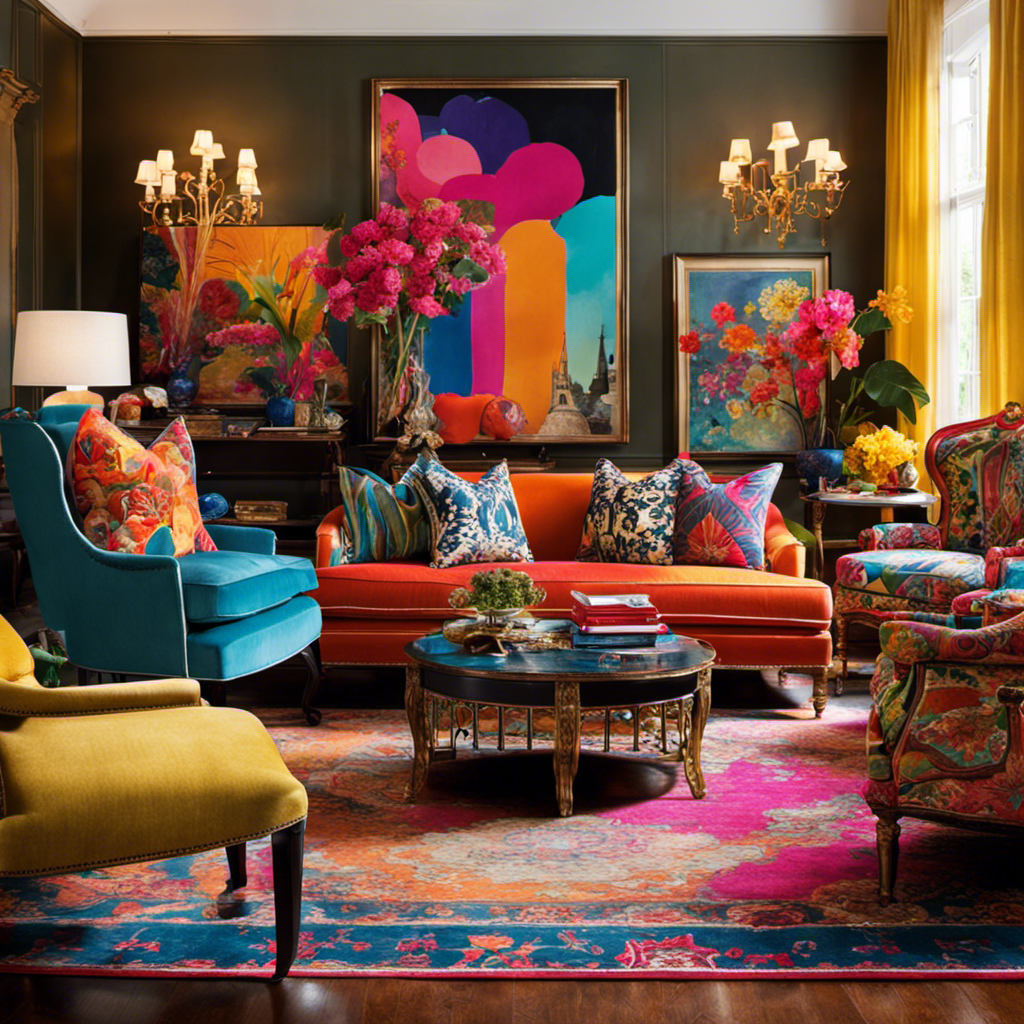
 Decor5 days ago
Decor5 days agoMaximalist Decor Explained: Embrace More Style
-

 Vetted4 weeks ago
Vetted4 weeks ago15 Best Drip Irrigation Systems to Keep Your Garden Thriving
-

 Vetted1 week ago
Vetted1 week ago15 Best Foot Massagers for Neuropathy to Soothe Your Feet and Relieve Discomfort
-

 Vetted2 weeks ago
Vetted2 weeks ago15 Best Sports Laundry Detergents for Keeping Your Activewear Fresh and Clean
-

 Vetted3 weeks ago
Vetted3 weeks ago15 Best Tall Toilets for Seniors That Combine Comfort and Safety
-

 Vetted3 weeks ago
Vetted3 weeks ago15 Best Dish Scrubbers to Keep Your Kitchen Sparkling Clean
-

 Decor3 weeks ago
Decor3 weeks agoWhat Is Eclectic Home Decor
-
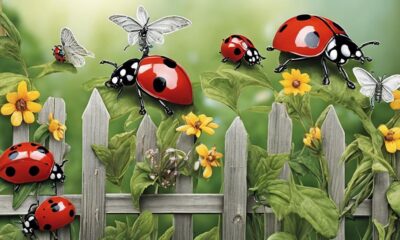
 Vetted2 days ago
Vetted2 days ago15 Best Organic Pest Control Solutions for a Naturally Pest-Free Home




